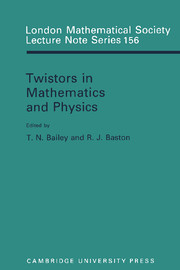Book contents
- Frontmatter
- Preface
- Contents
- 1 Twistor Theory After 25 Years—its Physical Status and Prospects
- 2 Between Integral Geometry and Twistors
- 3 Generalized Conformal Structures
- 4 Riemannian Twistor Spaces and Holonomy Groups
- 5 Twistors, Ambitwistors, and Conformal Gravity
- 6 The Penrose Transform
- 7 Notation for the Penrose Transform
- 8 The Twistor Transform
- 9 Invariant Operators
- 10 Penrose's Quasi-local Mass
- 11 The Sparling 3-form, Ashtekar Variables and Quasi-local Mass
- 12 Twistors and Strings
- 13 Integrable Systems in Twistor Theory
- 14 Twistor Characterization of Stationary Axisymmetric Solutions of Einstein's Equations
- 15 A Two-surface Encoding of Radiative Space-times
- 16 Twistors, Massless Fields and the Penrose Transform
- 17 Twistor Diagrams and Feynman Diagrams
- 18 Cohomology and Twistor Diagrams
- Authors' addresses
8 - The Twistor Transform
Published online by Cambridge University Press: 05 May 2013
- Frontmatter
- Preface
- Contents
- 1 Twistor Theory After 25 Years—its Physical Status and Prospects
- 2 Between Integral Geometry and Twistors
- 3 Generalized Conformal Structures
- 4 Riemannian Twistor Spaces and Holonomy Groups
- 5 Twistors, Ambitwistors, and Conformal Gravity
- 6 The Penrose Transform
- 7 Notation for the Penrose Transform
- 8 The Twistor Transform
- 9 Invariant Operators
- 10 Penrose's Quasi-local Mass
- 11 The Sparling 3-form, Ashtekar Variables and Quasi-local Mass
- 12 Twistors and Strings
- 13 Integrable Systems in Twistor Theory
- 14 Twistor Characterization of Stationary Axisymmetric Solutions of Einstein's Equations
- 15 A Two-surface Encoding of Radiative Space-times
- 16 Twistors, Massless Fields and the Penrose Transform
- 17 Twistor Diagrams and Feynman Diagrams
- 18 Cohomology and Twistor Diagrams
- Authors' addresses
Summary
Introduction and Motivation
There are two ways of describing a free Maxwell field on Minkowski space:
As a 2-form, F, subject to dF = 0 and d * F = 0 where * is the Hodge *-operator.
As an equivalence class of I-forms, Φ subject to d * dΦ = 0 where two 1-forms are said to be equivalent if their difference is of the form df for some function f.
Locally, these two descriptions are the same, the relationship between them being given by F = dΦ. The 1-form Φ is called a potential for the field F. Globally, this mapping Φ → F is neither injective nor surjective. There is a topological obstruction to finding a Φ for a given F and a similar topological obstruction to finding an f such that df = Φ when dΦ = O. This global inequivalence is of great interest since it requires one to determine experimentally which, if any, is the physically relevant description. The rather unexpected answer is ‘none of the above.’ Nowadays, it is well known that some combination of these two is required. The equivalence class of potentials Φ may be precisely re-interpreted as a connection on a trivial line bundle and allowing non-trivial line bundles with connection allows arbitrary fields F (as the curvature of this connection). The Aharonov-Bohm effect [2] provides a physical justification for this reformulation.
- Type
- Chapter
- Information
- Twistors in Mathematics and Physics , pp. 110 - 128Publisher: Cambridge University PressPrint publication year: 1990
- 1
- Cited by



